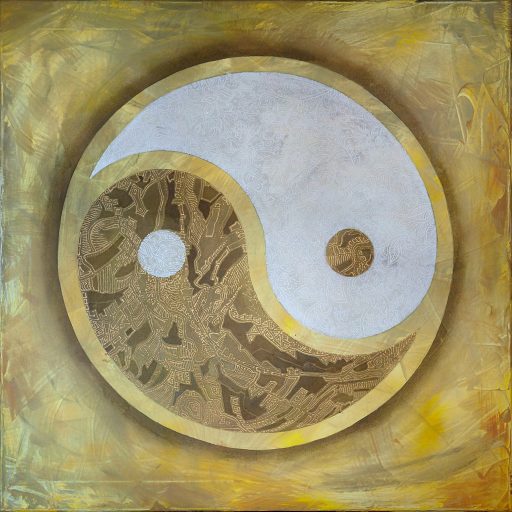Beyond the Veil
Throughout human civilisation, belief in supernatural and paranormal phenomena has been a profound and persistent aspect of our collective consciousness. From prehistoric cave art to contemporary religious practices, humanity has consistently sought to comprehend and interact with forces beyond our physical reality. This enduring pattern demonstrates not merely superstition, but sophisticated frameworks for understanding existence. From the intricate mythologies of ancient polytheistic cultures with their pantheons of gods and spirits to the structured theological frameworks of contemporary monotheistic traditions, the concept of an afterlife persists, shaping worldviews and influencing human behaviour.
Afterlife and Spirit Realm
Most religions share a belief in some form of afterlife or spirit realm where souls or consciousness continue to exist after death. This concept manifests in various ways across different faiths:
Buddhism
The Buddhist concept of afterlife is intricately tied to the cycle of rebirth (samsara). Buddhists believe in various realms of existence, including the human realm, heavenly realms, and lower realms such as the realm of hungry ghosts. The Tibetan Book of the Dead describes in detail the experiences of consciousness after death, including encounters with peaceful and wrathful deities.
Hinduism
Hindu beliefs encompass the concept of reincarnation (punarjanma) and multiple planes of existence (lokas). The Bhagavad Gita speaks of the immortality of the soul (atman) and its journey through various lives until it achieves moksha, or liberation from the cycle of rebirth.
Abrahamic religions
Judaism, Christianity, and Islam generally believe in concepts of heaven and hell, with some traditions also including the idea of purgatory. In Islam, for instance, the Quran describes Jannah (paradise) and Jahannam (hell) in vivid detail, while Catholic doctrine includes the concept of Purgatory as a state of purification before entering heaven.
Zoroastrianism
This ancient Persian religion holds beliefs in a spiritual realm and judgement after death. The Avesta, Zoroastrian sacred texts, describe the Chinvat Bridge, where souls are judged based on their earthly deeds.
Spiritual Intermediaries
Spiritual intermediaries serve as crucial connectors between divine and human spheres across multiple religious traditions. These entities facilitate communication, transmit divine power, and mediate between supernatural and earthly planes.
Angels: In Abrahamic religions, angels serve as messengers and protectors. Catholic theology includes a well-defined hierarchy of angels, such as Seraphim, Cherubim, and Thrones. The archangels Michael, Gabriel, and Raphael play significant roles in biblical narratives. Michael is often depicted as a warrior angel and the leader of the heavenly armies. Gabriel is known as the messenger angel, famous for announcing the birth of Jesus to Mary. Raphael is associated with healing and guidance, as described in the Book of Tobit.
Devas: In Buddhism and Hinduism, devas are benevolent spirits or celestial beings. The Rigveda, an ancient Hindu text, mentions various devas such as Indra (god of thunder and rain), Agni (god of fire), and Varuna (god of the celestial ocean). These devas are often associated with natural phenomena and are believed to have specific powers and domains of influence.
Loa: In Voodoo, these spirits serve as intermediaries between humans and the divine. Each loa has its own personality and domain of influence. For example, Papa Legba is associated with crossroads and communication, often invoked at the beginning of ceremonies to open the gates between the mortal and spirit worlds. Erzulie Freda is linked to love and beauty, while Baron Samedi is the loa of death and fertility.
Fravashis: Zoroastrianism includes these guardian spirits of individuals. The Yasna, a Zoroastrian liturgical text, describes fravashis as pre-existing souls that choose to incarnate to fight against evil. They are believed to protect and guide their living counterparts and continue to exist after death.
Malevolent Entities
Despite diverse theological perspectives, religious traditions share remarkable similarities in their conception of malevolent spiritual entities. From the demon hierarchies of Abrahamic faiths to the complex spiritual beings of Eastern traditions, these supernatural forces reflect humanity’s attempt to comprehend and contextualise the darker aspects of existence.
Demons: In Abrahamic religions, demons are considered fallen angels who serve Satan. In Catholic demonology, prominent demons include Beelzebub (the “Lord of the Flies”), often considered a high-ranking demon sometimes equated with Satan himself. Asmodeus is associated with lust and is mentioned in the Book of Tobit. Mammon is often personified as a demon of greed and wealth. Belphegor is associated with sloth, while Leviathan is sometimes considered a demon of envy.
Asuras and Rakshasas: Hinduism features these demonic beings that oppose the devas and cause harm to humans. The Ramayana, a Hindu epic, prominently features the rakshasa king Ravana as the main antagonist. Ravana is described as a powerful demon with ten heads, symbolising his vast knowledge and strength. Other notable rakshasas include Kumbhakarna, Ravana’s brother known for his immense size and prolonged sleep, and Surpanakha, Ravana’s sister who could change her form at will.
Mara: In Buddhism, Mara is a demon representing temptation and death, often trying to lead individuals away from enlightenment. The story of Buddha’s enlightenment includes his encounter with Mara and his daughters. Mara is said to have the ability to create illusions and manipulate desires to distract individuals from their spiritual path.
Angra Mainyu: Zoroastrianism includes this evil spirit who opposes Ahura Mazda, the supreme god. The cosmic battle between these forces is a central theme in Zoroastrian theology. Angra Mainyu is believed to be the source of all evil and darkness in the world, constantly trying to corrupt creation and lead humans astray.
Possession and Exorcism
Many traditions include beliefs about spiritual possession and methods for expelling malevolent entities:
Catholicism: The practice of exorcism is recognised to expel demons from possessed individuals. The Roman Ritual provides specific prayers and procedures for exorcisms, which can only be performed by authorised priests. The ritual involves commanding the demon to leave the possessed person in the name of Jesus Christ.
Judaism: The concept of dybbuk possession involves malevolent spirits of deceased individuals possessing living humans. The Baal Shem Tov, founder of Hasidic Judaism, was known for performing exorcisms. The process of removing a dybbuk often involves rituals, prayers, and sometimes the use of amulets or sacred objects.
Islam: Jinn possession is acknowledged, with some Islamic traditions including methods for expelling these entities. The ruqyah, a form of exorcism involving Quranic recitation, is practised in some Muslim communities. It is believed that certain verses of the Quran have protective and healing properties that can drive out malevolent spirits.
Voodoo: Spirit possession plays a central role in Voodoo practices and rituals. During ceremonies, practitioners may become “mounted” by loa, temporarily taking on the spirit’s personality and abilities. This form of possession is often seen as a positive experience, allowing direct communication with the spiritual realm.
Other Supernatural Entities
Religions worldwide feature a profound diversity of supernatural entities that extend far beyond traditional divine and demonic representations.
Yakshas: In Hinduism and Buddhism, yakshas are nature spirits that can be either benevolent or malevolent. They are often associated with natural phenomena and are believed to guard hidden treasures.
Ghede: In Voodoo, the Ghede are a family of spirits associated with death and fertility. Baron Samedi, the leader of the Ghede, is often depicted as a skeletal figure wearing a top hat and sunglasses.
Jinn: In Islamic tradition, jinn are beings created from smokeless fire. They can be good, evil, or neutral and are believed to inhabit a parallel world to humans.
Valkyries: In Norse mythology, Valkyries are female warrior spirits who choose which warriors will die in battle and escort their souls to Valhalla.
Kami: In Shinto, kami are spirits or phenomena that are worshipped. They can be elements of the landscape, forces of nature, or spirits of venerated dead persons.
Common Themes in Paranormal Beliefs
Despite the diversity of religious traditions, several common themes emerge in paranormal beliefs across cultures:
Hierarchical structure: Many religions organise supernatural entities into hierarchies. For example, the Nine Choirs of Angels in Catholicism or the hierarchies of devas and asuras in Hinduism and Buddhism. This structure often reflects societal organisations and power dynamics.
Influence on human affairs: Across religions, supernatural entities are often believed to influence human life, whether through guidance, temptation, or direct intervention. This belief can provide explanations for otherwise inexplicable events or experiences.
Moral dualism: Many traditions feature a cosmic struggle between good and evil forces, represented by opposing supernatural entities. This dualism often serves as a framework for understanding moral choices and the nature of existence.
Rituals and practices: Most religions include rituals or practices for interacting with or appeasing supernatural entities. These can range from daily prayers to complex ceremonies. For instance, the Catholic Mass involves the invocation of angels and saints, while Hindu pujas often include offerings to various deities.
The Universal Language
The persistence of supernatural beliefs across religion reveals more than mere coincidence. These parallel interpretations of similar phenomena suggest fundamental patterns in human consciousness and experience. While scientific advancement continues to expand our understanding of the physical universe, supernatural beliefs demonstrate remarkable adaptability, evolving alongside human society rather than being displaced by it. These beliefs serve multiple functions:
- Providing frameworks for understanding inexplicable experiences
- Creating meaningful narratives for human existence
- Establishing moral and ethical guidelines
- Building community cohesion through shared spiritual understanding
Rather than dismissing them as primitive superstitions or accepting them uncritically, it’s crucial to maintain an open mind, balancing scepticism with respect for diverse cultural beliefs. Understanding these beliefs offers valuable insights into human consciousness, cultural evolution, and our perpetual quest to comprehend existence beyond our immediate physical reality.
Further Reading:
- The Encyclopedia of Ghosts and Spirits by Rosemary Ellen Guiley – A comprehensive guide to supernatural entities across various cultures and religions.
- Angels: A History by David Albert Jones – An in-depth exploration of angelic beings in different religious traditions.
- Demons: A Definitive Guide to Demons and Demonology by Richard Kieckhefer – A scholarly examination of demonic entities in world religions and folklore.
- The Penguin Handbook of the World’s Living Religions edited by John R. Hinnells – A comprehensive overview of major world religions, including their beliefs in supernatural entities.
- The Cambridge Companion to Religious Studies edited by Robert A. Orsi – A collection of essays on various aspects of religious studies, including supernatural beliefs.
- Supernatural: Meetings with the Ancient Teachers of Mankind by Graham Hancock – An exploration of supernatural experiences across cultures and their impact on human consciousness.
- The Varieties of Religious Experience by William James – A classic work on the psychology of religion, including discussions on mystical and supernatural experiences.
- The Golden Bough by Sir James George Frazer – A seminal work in comparative religion and mythology, exploring supernatural beliefs across cultures.
- Religion Explained: The Evolutionary Origins of Religious Thought by Pascal Boyer – An anthropological perspective on why humans believe in supernatural entities.
- The Supernatural Book of Monsters, Spirits, Demons, and Ghouls by Alex Irvine – A comprehensive guide to supernatural entities in various mythologies and religions.




